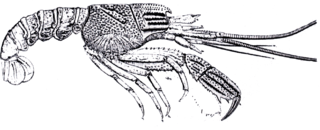 W
WActinoceramus is an extinct genus of fossil saltwater clams, marine pteriomorphian bivalve molluscs. These bivalves were facultatively mobile infaunal suspension feeders.
 W
WBelonostomus or Diphyodus is a genus of prehistoric ray-finned fish that was described by Louis Agassiz in 1844. Fossils range from 99.6 million years ago to 66 million years ago.
 W
WCalamopleurus is an extinct genus of bowfins, comprising three species: C. cylindricus and C. mawsoni from Brazil and C. africanus from Africa.
 W
WCallichimaera perplexa is a species of small crabs known from the Cretaceous Churuvita Group of Colombia and the Frontier Formation of the United States. Because it possesses a strange combination of anatomical features, it is said to be the "platypus of crabs". The presence of certain features in this species, such as its large claws and swimming limbs, confirm that those features were present in the crab lineage up to 95 million years ago. It evolved during the Cretaceous Crab Revolution.
 W
WCymatoceras is a wide-ranging extinct genus from the nautilitacean cephalopod family, Cymatoceratidae. They lived from the Late Jurassic to Late Oligocene, roughly from 155 to 23 Ma.
 W
WGlyphea is a genus of fossil glypheoid crustaceans that lived from the Jurassic to the Eocene. It includes the following species:
 W
WHippurites is an extinct genus of bivalve mollusc in the rudist family, from the Late Cretaceous of Africa, Asia, Europe, North America, and South America.
 W
WMacroscaphites is an extinct cephalopod genus included in the Ammonoidea that lived during the Barremian and Aptian stages of the Early Cretaceous. Its fossils have been found throughout most of Europe and North Africa.
 W
WNeithea is an extinct genus of bivalve mollusks that lived from the Early Jurassic to the early Paleocene, with a worldwide distribution. Neithia sp. are inequivalve. That means that the two valves are not the same shape, the right valve being strongly concave and the left valve being flattened or concave. Sculpture consist of alternating strong and weaker radiating ribs.
 W
WRequienia is an extinct genus of fossil saltwater clam, a marine bivalve molluscs in the order Hippuritida, family Requieniidae. These rudists lived in the Cretaceous period, from the Valanginian age (136.4–140.2) to the Campanian age. They were stationary intermediate-level suspension feeders.